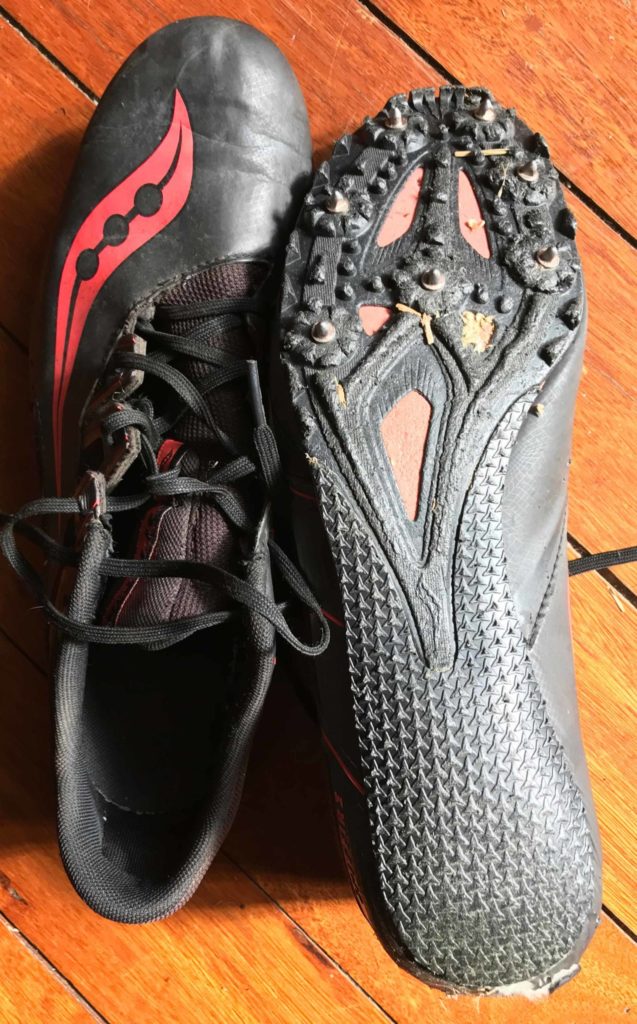How to Sprint Safely

Take Home Message
1. Running fast imposes an inherent risk of injuring the hamstrings or calves
2. Those most at risk are people who don’t have a strong background in running, who have a history of injury, and those who are middle aged and older
3. Healthy adults can sprint safely if they build a strong aerobic and strength base, strengthen their hamstring and calf muscles, and apply a sub-maximal approach to sprint training
4. Individuals who can’t safely sprint can use other high intensity training methods to achieve similar results
Why do Interval Training (IT)?
The many benefits of sprint training make it very appealing for those of us interested in aging successfully. This is certainly the case for me.
I began my sprinting journey about three years ago. I’d love to tell you a story of how, over this time, I was transformed from a novice into a sprinting god. But that would be a lie.
Instead, I offer you a cautionary tale.
Am I too old and beat up to sprint?
I began my sprinting journey sprinting up hills. I started easy and gradually built up volume over time. Everything was going well, then without warning I popped my calves. I rested, let my calves recover, and went back to the hill. I restarted at an easy pace, gradually building up volume. Then BOOM! Another calf strain.
At this point I concluded that hill sprints were out, so I switched to sprinting on flat ground. Again, at the beginning everything was going to plan. I was sprinting well, increasing my sprinting volume weekly, getting fitter and enjoying the workouts. Then out of the blue BAM! Hamstring tear. Sadly, I repeated this process twice, for a total of three separate hamstring tears, before I finally stopped and asked the question. Am I too old and beat up to be able to sprint safely?
Fortunately, the answer turned out to be no. However, it took time to develop the approach that now allows me to sprint safely and not get injured. Here, I outline how I sprint without getting injured.
My hope is that this information can help others do the same.
Hill Sprints versus Flat Sprinting
There are two safe sprinting options on the table: sprinting on flat ground versus sprinting uphill. We don’t recommend sprinting on treadmills. Sprinting on treadmills carries a high risk of injury, not to mention public humiliation. Avoid.
Sprinting on flat ground
The easiest option for most people is sprinting on flat ground. This can be done on a running track, a playing field, or a flat section of your local park. As hamstring injuries are by far the most common injury related to high-speed running 1, incurring a hamstring injury is the biggest risk associated with sprinting on flat ground. However, sprinting remains a safe option, if you take the time to strengthen your hamstrings (see our follow up article on strengthening the hamstrings for sprinting), follow a sensible sprinting program and use good sprinting technique.
Hill Sprints
The alternative to sprinting on flat ground is uphill sprinting. I first learned of the conditioning benefits of hill sprinting through the superb writing of Jim Wendler. Many studies have confirmed what strength and conditioning coaches and athletes have known for a long time: Hill sprints improve athletic performance (for example see 2-4) .

A significant advantage to hill sprints is that they place less strain on the hamstring than conventional sprint training 5. Anecdotally, I have torn my hamstrings several times when sprinting on the flat ground, but I have never torn a hamstring when performing hill sprints.
Thus, the training benefits of hill sprinting are high, while the risk of hamstring injury is low. For these reasons I recommend hill sprints for older athletes, or those athletes who don’t have a strong background in running.
An important caveat is that hill sprints place tremendous strain on the calves. If you’ve been neglecting your calf training and launch into hill sprinting, then prepare yourself for a calf strain. Unless you have been running for a long time, I highly recommended that you prepare both your hamstrings and calves before starting any sprint training program (see our fourth article on sprinting: preparing the calves for sprinting).
How to sprint safely
1. Choose a safe sprinting venue, and if necessary train with other like-minded people
In my experience, far fewer people regularly sprint than jog or cycle, so most of the time you will be training by yourself. This is especially true if you are performing hill sprints. Because good sprinting hills are often isolated, they present a potentially risky venue for women and other at-risk individuals when training alone.
For this reason, if you think that you might be at risk, I recommend that you use sprint training is an opportunity to reach out to other like-minded individuals and train as a group.
2. Build a strength and aerobic base before commencing sprint training
The safety of high intensity training for inactive individuals has been questioned in the literature 6-8.
For reasons of safety, I highly recommend that you invest in building an aerobic base and developing some lower body strength before you launch into sprinting. It’s difficult to overstate the general health benefits of maintaining a strong aerobic base 9. Further, humans with superior cardiovascular fitness 10 11 and strength 12 are far more robust to injury. It follows that you should develop both qualities before you commence sprinting to prevent injury.
Importantly, you should devote time to strengthening your hamstrings and calves, as these are the muscles most prone to injury when sprinting 1,13. This is especially important for people like myself who do not have a strong background in running, have a history of running-related injury and are middle aged or older.
3. Don’t sprint when tired or dehydrated
It’s well known that sprinting when tired greatly increases your chances of injury 1,14, so don’t do it. My personal experience indicates that the probability of injury is also increased when sprinting in a dehydrated state. It’s always a good idea to be fully hydrated in general, and this is especially true when you are training hard in the warmer months. Stay hydrated.
For the record, sprinting with a hangover significantly increase the probability of a hamstring tear and is not recommended.
4. Always perform a pre-sprint warm-up
Performing an appropriate warm-up is essential before commencing any type of training. If the training session is a sprint session, you must perform additional warm-up exercises to prepare your legs for the high demands of sprinting. A sprinting-specific warm-up is mandatory to avoid the dreaded hamstring tear or calf strain.
If I’m sprinting, I perform the following routine for three rounds without a break after my general warm-up is finished.
| Pre-sprint dynamic warm-up Routine | |
| Exercise | Reps |
| Heel kicks | 20 per leg |
| Toe Touch (or as close to toe touch as your mobility permits) | 20 |
| Upward Front Kick | 10 per leg |
| Cossack Groin Stretch | 10 per leg |
After this I perform a few light jogs to thoroughly warm-up the hamstring, hips and calves.
There are many pre-sprint warm-up routines published online, so pick one that you like that addresses your weak areas.
Warming up is mandatory to prepare your hamstrings, groin, calves, quads and hips for the high-intensity work to come. If you don’t have time to warm up, don’t sprint, period.
5. Always include some warm-up sprints
Once you’ve done your pre-sprint warm-up, the next step is to perform several lighter sprint-sets before you hit your top speed sets for the session. My first sprint is around 40% of flat out pace, my second sprint around 60%, my third sprint about 75%, and my fourth and remaining working sprint sets are performed at 80-85% of flat out effort.
These days, I rarely if ever sprint at 100% pace. As a result, I don’t get injured.
In addition, remember to pay attention during your warm-up sets and use them to gauge the state of your body before you commence the high intensity sprints. If your legs are tired or you feel a twinge when you shouldn’t, you should stop altogether (highly recommended) or commit to a lighter sprint session.
6. Sprint at 85% your maximal effort, not 100%
The published studies recommend performing sprint interval training at a ‘flat-out’ pace. For training that involves fast running, I think that going flat out is a bad idea. This is because running at full pace greatly increases the probability of injuring either your hamstring 1,14 or your calf muscle 15. Sprinting flat out is especially risky for older adults, anyone who doesn’t have strong running background, and those with a history of either hamstring or calf injury.
Sadly, I meet all three criteria. It’s therefore no coincidence that all of my sprinting injuries have occurred when sprinting flat-out. Now my goal is to make every stride identical and make my last working set look the same as my first working set. I can only achieve this robotic approach to sprint training if I train sub-maximally.
To do this, I set my maximum training pace to 80-85% of flat-out sprinting. At this pace I’m working hard but I’m still able to maintain good technique for the entire work-out, which minimises the chance of injury.
Using a sub-maximal approach to sprint training is a good way to consistently perform high-quality sprint workouts over a long period of time. This approach to sprinting (and training in general) is highly recommended for people who like to train hard, but don’t like to get injured.
7. Use Shorter Strides
Hamstrings are most vulnerable to tears when they are contracting from a fully stretched position during sprinting 1,14. My hamstring tears have all occurred when sprinting at full stride. To minimise the risk of hamstring injury, I now sprint with a slightly shorter stride and I recommend that you do as well.
One of the advantages of running uphill is that it naturally forces you into a shorter stride and takes some of the strain from the hamstring by transferring it to the hips, reducing stress on the hamstrings.
8. Start Easy, Build Gradually
You may be tempted to go hard when you start sprint training. Do yourself a huge favour and resist this temptation. If you are training to get in shape without injuring yourself, then you should keep in mind that running fast imposes a significant risk of injury 1. The benefits of sprint training accrue with months of consistent effort and gradual progression. If you are injured, you won’t be able to train consistently enough to make any meaningful progress.
To avoid injury, I recommend that initially you focus on perfecting your sprinting technique and let your body slowly adapt to the demands of sprinting. Begin with a low number of total sprints, perhaps as little as 4-5 sets, consisting of three warm-up sets and 1-2 work sets. Keep your maximal effort work sets at around 60-70% of flat-out for the first few weeks. Then gradually increase your work sets to an 85% intensity. Once you can comfortably maintain this pace for all of your work sets, slowly begin to add more work sets to increase your sprinting volume.
Although the action shots of elite sprinters exploding out of the blocks at the Olympics look amazing, remember that you are not at the Olympics. It is not a good idea to start your sprints like you’ve been shot out of a cannon. Exploding from zero to top speed increases the risk of injury, particularly calf strain, for no good reason. Therefore, I suggest that you take a few steps to accelerate up to your working speed.
9. Stop Immediately if Injured
If you feel a twinge of an injury while sprinting, stop immediately. The workout is finished.
Go home, do some active recovery (rest, ice, compression, elevation). Assess the injury and if you need to see a Doctor, make an appointment. Stopping training when an injured improves the chance of a fast recovery and getting back to training within a few days. In contrast, continuing to train with even a minor injury greatly increases the probability of the injury escalating from mild to serious, which could leave you side-lined you for weeks, if not months.
10. Sprinting intervals
Sprinting should take 10-30 seconds, and the recovery should last long enough so that the next sprinting interval can be performed using good technique at the appropriate level of effort. For my hill, my sprint time is roughly 15 seconds and the walk back to the bottom takes a bit less than one minute. This work-rest timing is in good agreement with the literature, which recommend sprinting for 10-30 seconds and resting 1- 4 minutes between sprints 16,17.
On the hills you can shorten the rest intervals for a greater conditioning effect because hill sprints are safer, assuming your calves are sufficiently conditioned to handle hard hill sprints. If you are sprinting on flat ground, I recommend longer rest periods to reduce the probability of incurring a hamstring injury.
11. Sprinting volume and frequency
The principle of sub-maximal training also applies to selecting the total volume of your sprinting workout. Instead of training to exhaustion, set your sprinting volume to where you can maintain good form for each-and-every sprint interval. This is usually within the 75-85% range.
I like to keep my sprint workouts to about 20 minutes in length, not including warm-ups. For my hill this equates to 10-15 sprints, done two to three times per week.
This sprinting volume and frequency is effective and doesn’t wipe me out, which in turn keeps me motivated, injury free and therefore consistent. This is another example of sub-maximal training.
You will have to experiment to find your own sprinting volume sweet spot. Consistency is the foundation for all successful training. For this reason, I recommend that you constrain your sprinting volume and frequency that allows you to perform quality sprints week in, week out. Month in, month out.
Generally, less is more.
The Safe Sprinting Checklist

- Choose a safe venue and time. If necessary, train as a group
- Develop a solid aerobic base and strength base
- Strengthen your hamstrings and calves
- Thoroughly warm-up before sprinting
- Start each session slowly, gradually building up to your working sets
- Sprint at 80-85% maximal pace, not all-out
- Use good sprinting technique, taking slightly shorter steps to protect your hamstrings
- Don’t explode at the start, take a few strides to get up to top speed
- Stop immediately if injured
- Intervals should consist of 10-30 second sprints, 1-4 minutes of rest
- Scale your sprinting volume and frequency as appropriate for your fitness level, ability to recover, and lifestyle
Conclusion
Sprinting is a proven method that increases your fitness while helping you lose weight and gain lean muscle. Furthermore, sprinting also has the additional benefits of improving and maintaining bone density and increasing the athletic attributes of speed, power, strength and agility.
Unfortunately, hamstring and calf injuries are an inherent risk to running fast. To minimise the chance of injury, I strongly suggest that you strengthen the hamstrings and calves while building an aerobic and strength base. Once you have built a solid foundation, apply a sub-maximal approach to sprint training. Finally, enjoy the many health benefits that only sprinting can provide!
References and Further Reading
1 Tokutake, G. et al. The Risk Factors of Hamstring Strain Injury Induced by High-Speed Running. J Sports Sci Med 17, 650-655 (2018).
2 Sandvei, M. et al. Sprint interval running increases insulin sensitivity in young healthy subjects. Arch Physiol Biochem 118, 139-147, doi:10.3109/13813455.2012.677454 (2012).
3 Jakeman, J. R., McMullan, J. & Babraj, J. A. Efficacy of a Four-Week Uphill Sprint Training Intervention in Field Hockey Players. J Strength Cond Res 30, 2761-2766, doi:10.1519/JSC.0000000000001373 (2016).
4 Kavaliauskas, M., Kilvington, R. & Babraj, J. Effects of in-season uphill sprinting on physical characteristics in semi-professional soccer players. J Sports Med Phys Fitness 57, 165-170, doi:10.23736/S0022-4707.16.06066-7 (2017).
5 Slawinski, J. et al. Elite long sprint running: a comparison between incline and level training sessions. Med Sci Sports Exerc 40, 1155-1162, doi:10.1249/MSS.0b013e3181676681 (2008).
6 Keteyian, S. J. Swing and a miss or inside-the-park home run: which fate awaits high-intensity exercise training? Circulation 126, 1431-1433, doi:10.1161/CIRCULATIONAHA.112.129171 (2012).
7 Halle, M. Letter by Halle regarding article, “Cardiovascular risk of high- versus moderate-intensity aerobic exercise in coronary heart disease patients”. Circulation 127, e637-e637, doi:10.1161/CIRCULATIONAHA.112.150441 (2013).
8 Levinger, I. et al. What Doesn’t Kill You Makes You Fitter: A Systematic Review of High-Intensity Interval Exercise for Patients with Cardiovascular and Metabolic Diseases. Clin Med Insights Cardiol 9, 53-63, doi:10.4137/CMC.S26230 (2015).
9 Ito, S. High-intensity interval training for health benefits and care of cardiac diseases – The key to an efficient exercise protocol. World J Cardiol 11, 171-188, doi:10.4330/wjc.v11.i7.171 (2019).
10 Malone, S., Roe, M., Doran, D. A., Gabbett, T. J. & Collins, K. D. Protection Against Spikes in Workload With Aerobic Fitness and Playing Experience: The Role of the Acute:Chronic Workload Ratio on Injury Risk in Elite Gaelic Football. Int J Sports Physiol Perform 12, 393-401, doi:10.1123/ijspp.2016-0090 (2017).
11 Watson, A., Brickson, S., Brooks, M. A. & Dunn, W. Preseason Aerobic Fitness Predicts In-Season Injury and Illness in Female Youth Athletes. Orthopaedic journal of sports medicine 5, 2325967117726976-2325967117726976, doi:10.1177/2325967117726976 (2017).
12 Lauersen, J. B., Andersen, T. E. & Andersen, L. B. Strength training as superior, dose-dependent and safe prevention of acute and overuse sports injuries: a systematic review, qualitative analysis and meta-analysis. Br J Sports Med 52, 1557-1563, doi:10.1136/bjsports-2018-099078 (2018).
13 Green, B. et al. Calf muscle strain injuries in elite Australian Football players: A descriptive epidemiological evaluation. Scand J Med Sci Sports 30, 174-184, doi:10.1111/sms.13552 (2020).
14 Shield, A. J. & Bourne, M. N. Hamstring Injury Prevention Practices in Elite Sport: Evidence for Eccentric Strength vs. Lumbo-Pelvic Training. Sports Med 48, 513-524, doi:10.1007/s40279-017-0819-7 (2018).
15 Fields, K. B. & Rigby, M. D. Muscular Calf Injuries in Runners. Curr Sports Med Rep 15, 320-324, doi:10.1249/JSR.0000000000000292 (2016).
16 Yamagishi, T. & Babraj, J. Active Recovery Induces Greater Endurance Adaptations When Performing Sprint Interval Training. J Strength Cond Res 33, 922-930, doi:10.1519/JSC.0000000000002787 (2019).
17 Schoenmakers, P. P. J. M., Hettinga, F. J. & Reed, K. E. The Moderating Role of Recovery Durations in High-Intensity Interval-Training Protocols. Int J Sports Physiol Perform 14, 859–867-859–867, doi:10.1123/ijspp.2018-0876 (2019).
Disclaimer
The material displayed on this website is provided without any guarantees, conditions or warranties as to its accuracy.
Information written and expressed on this website is for education purposes and interest only. It is not intended to replace advice from your medical or healthcare professional.
You are encouraged to make your own health care choices based on your own research and in conjunction with your qualified practitioner.
The information provided on this website is not intended to provide a diagnosis, treatment or cure for any diseases. You should seek medical attention before undertaking any diet, exercise, other health program or other procedure described on this website.
To the fullest extent permitted by law we hereby expressly exclude all warranties and other terms which might otherwise be implied by statute, common law or the law of equity and must not be liable for any damages whatsoever, including but without limitation to any direct, indirect, special, consequential, punitive or incidental damages, or damages for loss of use, profits, data or other intangibles, damage to goodwill or reputation, injury or death, or the cost of procurement of substitute goods and services, arising out of or related to the use, inability to use, performance or failures of this website or any linked sites and any materials or information posted on those sites, irrespective of whether such damages were foreseeable or arise in contract, tort, equity, restitution, by statute, at common law or otherwise.

Ten Minutes is All You Need
Research has shown that ten minutes of moderate-to-vigorous exercise performed each day is enough to significantly reduce your risk of early death.

Strong Bones, Strong Mind
Regular exercise releases osteocalcin from your bones. Once in circulation, osteocalcin enters your brain to support learning and memory.




